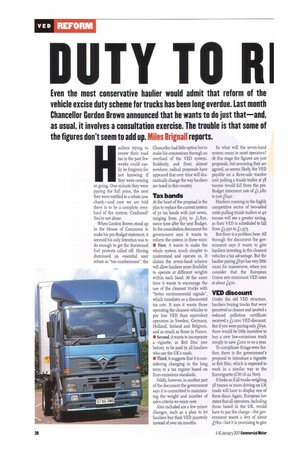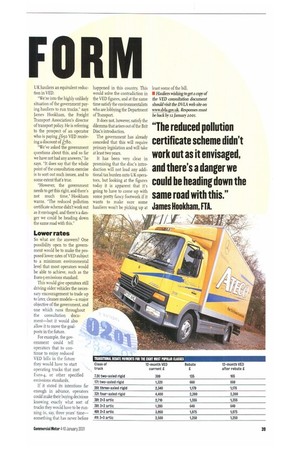IIITIT TO RI FORM
Page 40

Page 41

If you've noticed an error in this article please click here to report it so we can fix it.
Even the most conservative haulier would admit that reform of the vehicle excise duty scheme for trucks has been long overdue. Last month Chancellor Gordon Brown announced that he wants to do just that—and, as usual, it involves a consultation exercise. The trouble is that some of the figures don't seem to add up. Miles Brignall reports.
Hauliers trying to renew their road tax in the past few weeks could easily be forgiven for not knowing if they were coming or going. One minute they were paying the full price, the next they were entitled to a rebate (see chart)—and now we are told there is to be a complete overhaul of the system. Confused? You're not alone.
When Gordon Brown stood up in the House of Commons to make his pre-Budget statement, it seemed his only intention was to do enough to get the threatened fuel protests called off. Having dismissed an essential user rebate as "too cumbersome", the Chancellor had little option but to make his concessions through an overhaul of the VED system. Suddenly, and from almost nowhere, radical proposals have appeared that over time will dramatically change the way hauliers are taxed in this country.
Tax bands
At the heart of the proposal is the plan to replace the current system of 5o tax bands with just seven, ranging from Li65 to 11,850, some time after the next Budget. In the consultation document the government says it wants to reform the system in three ways: • First, it wants to make the whole system much simpler to understand and operate in. It claims the seven-band scheme will allow hauliers more flexibility to operate at different weights within each band. At the same time it wants to encourage the use of the cleanest trucks with 'better environmental signals", which translates as a discounted tax rate. It says it wants those operating the cleanest vehicles to pay less VED than equivalent operators in Sweden, Germany, Holland, Ireland and Belgium, and as much as those in France.
• Second, it wants to incorporate a vignette, or Brit Disc (see below), to be paid by all hauliers who use the UK's roads.
• Third, it suggests that it is considering changing in the long term to a tax regime based on Euro emissions standards.
Oddly, however, in another part of the document the government says it is committed to maintaining the weight and number of axles criteria we enjoy now.
Also included are a few minor changes, such as a plan to let hauliers buy their VED quarterly instead of over six months. So what will the seven-band system mean to most operators? At this stage the figures are just proposals, but assuming they are agreed, as seems likely, the VED payable on a three-axle tractive unit pulling a triaxle trailer at 38 tonnes would fail from the preBudget statement rate of £1,280 to just £640.
Hauliers running in the highly competitive sector of two-axkd units pulling triaxle trailers at 40 tonnes will see a greater saving, as their VED is scheduled to fall from £3,950 to £1,975.
But there is a problem here. All through the document the government says it wants to give hauliers investing in the cleanest vehicles a tax advantage. But the haulier paying £65o has very little room for manoeuvre, when you consider that the European Union sets minimum VED rates at about Ivo.
VED discount
Under the old VED structure, hauliers buying trucks that were perceived as cleaner and sported a reduced pollution certificate received a i1,000 VED discount. But if you were paying only £6o, there would be little incentive to buy a new low-emissions truck simply to save Izoo or so a year.
To complicate things even further, there is the government's proposal to introduce a vignette or Brit Disc, which is expected to work in a similar way to the Eurovignette (CM1G-22. Nov).
It looks as if all trucks weighing 38 tonnes or more driving on UK roads will have to display one of these discs. Again, European law states that all operators, including those based in the UK, would have to pay the charge—the government wants a levy of about £78o—but it is promising to give UK hauliers an equivalent reduction in VED.
"We're into the highly unlikely situation of the government paying hauliers to run trucks," says James Hookham, the Freight Transport Association's director of transport policy. He is referring to the prospect of an operator who is payingi6 so VED receiving a discount of k80.
"We've asked the government questions about this, and so far we have not had any answers," he says. "It does say that the whole point of the consultation exercise is to sort out such issues, and to some extent that's true.
"However, the government needs to get this right, and there's not much time," Hookham warns. "The reduced pollution certificate scheme didn't work out as it envisaged, and there's a danger we could be heading down the same road with this."
Lower rates
So what are the answers? One possibility open to the government would be to make the proposed lower rates of VED subject to a minimum environmental level that most operators would be able to achieve, such as the Euro-3 emissions standard.
This would give operators still driving older vehicles the necessary encouragement to trade up to later, cleaner models—a major objective of the government, and one which runs throughout the consultation document—but it would also allow it to move the goalposts in the future.
For example, the government could tell operators that to continue to enjoy reduced VED bills in the future they would have to start operating trucks that met Euro-4, or other specified emissions standards.
If it stated its intentions far enough in advance, operators could make their buying decisions knowing exactly what sort of trucks they would have to be running in, say, three years' time— something that has never before happened in this country. This would solve the contradiction in the VED figures, and at the same time satisfy the environmentalists who are lobbying the Department of Transport.
It does not, however, satisfy the dilemma that arises out of the Brit Disc's introduction.
The government has already conceded that this will require primary legislation and will take at least two years.
It has been very clear in promising that the disc's introduction will not load any additional tax burden onto UK operators, but looking at the figures today it is apparent that it's going to have to come up with some pretty fancy footwork if it wants to make sure some hauliers won't be picking up at least some of the bill.
• Hauliers wishing to get a copy of the VED consultation document should visit the DVIA web site on www.dvla.gov.uk Responses must be back by 12 Pintail, 2001.




























































































